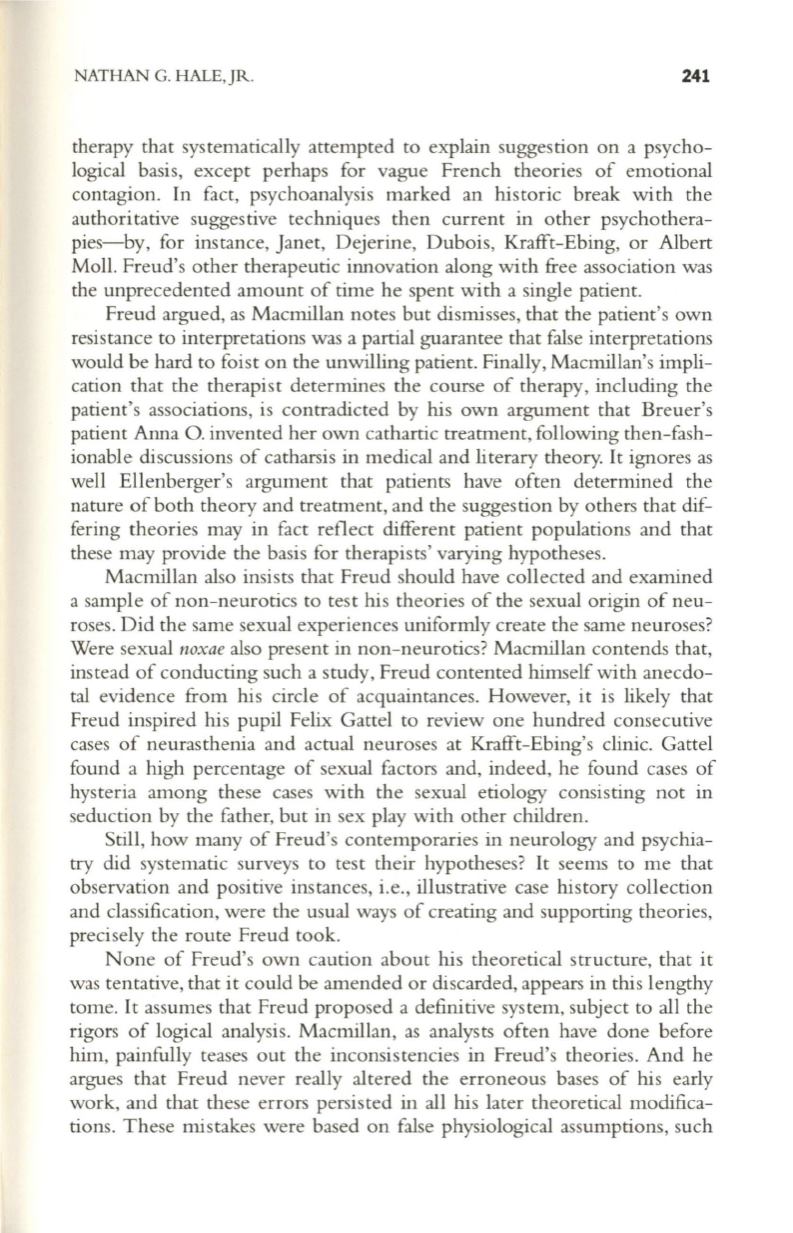
NATHAN G. HALE,JR.
241
therapy that systematically attempted to explain suggestion on a psycho–
logical basis, except perhaps for vague French theories of emotional
contagion. In fact, psychoanalysis marked an historic break with the
authoritative suggestive techniques then current in other psychothera–
pies-by, for instance, Janet, Dejerine, Dubois, Krafft-Ebing, or Albert
Moll. Freud's other therapeutic innovation along with free association was
the unprecedented amount of time he spent with a single patient.
Freud argued, as Macmillan notes but dismisses, that the patient's own
resistance to interpretations was a partial guarantee that false interpretations
would be hard to foist on the unwilling patient. Finally, Macmillan's impli–
cation that the therapis t determines the course of therapy, including the
patient's associations, is contradicted by his own argument that Breuer's
patient Anna O . invented her own cathartic treatment, following then-fash–
ionable discussions of catharsis in medical and literary theory.
It
ignores as
well Ellenberger's argument that patients have often determined the
nature of both theory and treatment, and the sugges tion by others that dif–
fering theories may in fact reflect different patient populations and that
these may provide the basis for therapists' varying hypotheses.
Macmillan also insists that Freud should have collected and examined
a sample of non-neurotics to test his theories of the sexual origin of neu–
roses. Did the same sexual experiences uniformly create the same neuroses?
Were sexual
noxae
also present in non-neurotics? Macmillan contends that,
instead of conducting such a study, Freud contented himself with anecdo–
tal evidence from his circle of acquaintances. However, it is likely that
Freud inspired his pupil Felix Gattel to review one hundred consecutive
cases of neurasthenia and actual neuroses at Krafft-Ebing's clinic. Gattel
found a high percentage of sexual factors and, indeed, he found cases of
hysteria among these cases with the sexual etiology consisting not in
seduction by the father, but in sex play with other children.
Still, how many of Freud's contemporaries in neurology and psychia–
try did systematic surveys to test their hypotheses?
It
seems to me that
observation and positive instances, i.e., illustrative case history collection
and classification, were the usual ways of creating and supporting theories,
precisely the route Freud took.
None of Freud's own caution about his theoretical structure, that it
was tentative, that it could be amended or discarded, appears in this lengthy
tome.
It
assumes that Freud proposed a definitive system, subject to all the
rigors of logical analysis. Macmillan, as analysts often have done before
him, painfully teases out the inconsistencies in Freud's theories. And he
argues that Freud never really altered the erroneous bases of his early
work, and that these errors persisted in all his later theoretical modifica–
tions. These mistakes were based on false physiological assumptions, such


